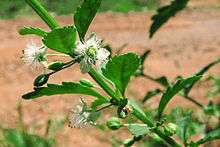Scoparia dulcis
| Scoparia dulcis | |
|---|---|
 | |
| Scientific classification | |
| Kingdom: | Plantae |
| (unranked): | Angiosperms |
| (unranked): | Eudicots |
| (unranked): | Asterids |
| Order: | Lamiales |
| Family: | Plantaginaceae |
| Genus: | Scoparia |
| Species: | S. dulcis |
| Binomial name | |
| Scoparia dulcis L. | |
| Synonyms[1] | |
| |

Scoparia dulcis is a species of flowering plant in the plantain family. Common names include licorice weed,[2] goatweed,[3] scoparia-weed and sweet-broom in English, tapeiçava, tapixaba, and vassourinha in Portuguese, escobillo in Spanish, and tipychä kuratu in Guarani.[4] It is native to the Neotropics but it can be found throughout the tropical and subtropical world.[4]
Although S. dulcis is considered a weed in many parts of Bangladesh, its use in traditional medicine has led to overexploitation.[5] The plant is also found as a weed in Florida citrus groves.[3]
Traditional medicine
As a traditional medicine, S. dulcis has been used for diabetes in India and hypertension in Taiwan.[6] In Brazil, it has been used for various problems such as hemorrhoids and wounds,[7] while it is used for sickle-cell disease in Nigeria.[8] In Nicaragua, it has been used for anemia, burns, and headaches.[9]
Chemical constituents
Chemicals that have been isolated from S. dulcis include scoparinol,[10] scoparic acid, scopadulcic acid, scopadulciol, and scopadulin.[11]
References
- ↑ The Plant List: A Working List of All Plant Species, retrieved 22 May 2016
- ↑ "Scoparia dulcis". Natural Resources Conservation Service PLANTS Database. USDA. Retrieved 8 November 2015.
- 1 2 Jain, Rakesh; Singh, Megh (1989). "Factors Affecting Goatweed (Scoparia dulcis) Seed Germination". Weed Science. 37 (6): 766–70. JSTOR 4044996.
- 1 2 Scoparia dulcis. Germplasm Resources Information Network.
- ↑ Majumder, S; Rahman, MM; Bhadra, SK (2011). "Micropropagation of Scoparia dulcis Linn. through induction of indirect organogenesis" (PDF). Asia-Pacific Journal of Molecular Biology and Biotechnology. 19 (1): 11–7.
- ↑ Pari, Leelavinothan; Latha, Muniappan (2004). "Protective role of Scoparia dulcis plant extract on brain antioxidant status and lipidperoxidation in STZ diabetic male Wistar rats". BMC Complementary and Alternative Medicine. 4: 16. doi:10.1186/1472-6882-4-16. PMC 533881
 . PMID 15522116.
. PMID 15522116. - ↑ Freire, SM; Torres, LM; Souccar, C; Lapa, AJ (1996). "Sympathomimetic effects of Scoparia dulcis L. And catecholamines isolated from plant extracts". The Journal of pharmacy and pharmacology. 48 (6): 624–8. doi:10.1111/j.2042-7158.1996.tb05985.x. PMID 8832498.
- ↑ Murti, Krishna; Panchal, Mayank; Taya, Poonam; Singh, Raghuveer (2012). "Pharmacological Properties of Scoparia Dulcis: A Review". Pharmacologia. 3 (8): 344. doi:10.5567/pharmacologia.2012.344.347.
- ↑ Rashid, M. H.; Khalekuzzaman, M.; Hasan, M. F.; Das, R.; Hossain, M. S.; Mahabbat, S.; Mahabbat-e Khoda, S (2009). "Establishment of an Efficient. Method for Micropropagation of an Important Medicinal Herb (Scoparia dulcis L.) from Shoot Tips and Nodal Segments" (PDF). International Journal of Sustainable Crop Production. 4 (1): 5–9.
- ↑ Ahmed, M; Shikha, HA; Sadhu, SK; Rahman, MT; Datta, BK (2001). "Analgesic, diuretic, and anti-inflammatory principle from Scoparia dulcis". Die Pharmazie. 56 (8): 657–60. PMID 11534346.
- ↑ Zulfiker, Abu Hasanat; Ripa, Farhana Alam; Rahman, Mahbubur; Ullah, M. Obayed; Hamid, Kaiser; Khan, Mahbubur Rahman; Rana, Sohel (2010). "Antidiabetic and antioxidant effect of Scoparia dulcis in alloxan induced albino mice" (PDF). International Journal of PharmTech Research. 2 (4): 2527–34.
External links
-
 Media related to Scoparia dulcis at Wikimedia Commons
Media related to Scoparia dulcis at Wikimedia Commons